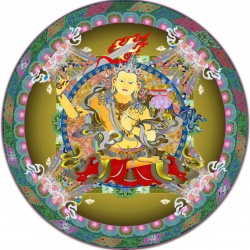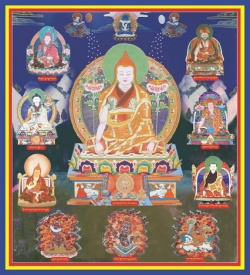The Development of Tibet Buddhism
Tibet Buddhism has been developed under the reign of Trisong Detsen and Sadnalegs, especially the Buddhists were allowed to participate in government and political affairs, which also triggered a conflict with the royal family.
The Development of Buddhism –Ralpacan
According to traditional sources, Ralpacan is the 41st King of Tibet, ruling from the death of his father Sadnalegs. He was the second of five brothers and referred to be the 'Son of God'. His elder brother Langdarma was the anti-Buddhist who advocated the disaster of Buddhism. Ralpacan is considered very important to the history of Tibetan Buddhism as one of the three Dharma Kings - Songtsen Gampo, Trisong Detsen and himself. Trisong Detsen had five wives, all from Tibetan noble families.
He was a generous supporter of Buddhism and invited many craftsmen, scholars and translators to Tibet from China, Nepal, Kashmir and Khotan. He also promoted the development of Tibetan literature and translations, which were greatly aided by the development of a detailed Sanskrit-Tibetan lexicon called the Mahavyutpatti which included standard Tibetan equivalents for thousands of Sanskrit terms. He decreed that all translations must be done directly from Sanskrit.
The Development of Buddhism – The Second Disaster of Buddhism
While the quick development of Buddhism, the political power was mostly controlled by Buddhists. When Langdarma ascended the throne to be the last emperor of the unified Tibetan empire, the second disaster of Buddhism was held by him. At the first two years of his rule, he's still a Buddhist, but with the influence of families, he became a Bon follower. Due to solidify the right of royal family, Langdarma advocated the second disaster of Buddhism, which was the serious challenge to Buddhism.
Firstly, he prohibited Tibetan people to build Monastery and closed the current monastery, which contained the Jokhang Temple and Ramoche Temple.
Secondly, the Buddhism treasures were damaged, for example, the statue of Sakyamuni has been buried.
Thirdly, the Buddhist Scriptures were destroyed by fire or threw into the river.
Fourthly, when he took the throne, he ordered the army to suppress the Buddhists. Most of Buddhists fled into India but some of them were murdered in half way.
Langdarma was finally killed during the process of counterattack of Buddhists, namely the Tu Bo Dynasty was disorganizing as the internal strife. During the time of more than one century, the Buddhism is basically disappeared in Tibet society, which called the 'Dark Ages'.
The Development of Buddhism - Revival
There were three monks fled into Ngari Prefecture during the disaster of Buddhism. A local Tibetan people who became the famous Buddhist and played the important status of Tibetan history followed them and formally acknowledged them as his master. During his life, he applied himself to held many movements of Buddhism Dharma as the centre of Dandou Temple. Until the coming of 11 century, Buddhism was greatly reviving again in Tibet Region.

